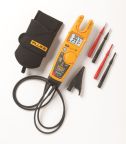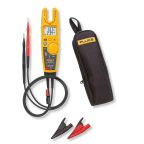Fluke Voltage Testers
Fluke's Voltage Testers are easy to use and provide accurate readings of voltage, current and resistance. Fluke's non-contact testers offer quick, accurate testing in tight spaces where there is little room for error or incorrect readings.
Fluke's Two Pole Voltage Testers feature a pistol grip shape designed for maximum comfort and control over long periods of use. With several other models to choose from, one is sure to fit your needs! When working with electricity, the right tester can be the difference between a safe job and an unfortunate accident. Fluke's non-contact voltage detectors provide electricians the confidence to perform their work from a safe distance. Fluke's voltage testers can be used at home and in the workplace by electricians and engineers to quickly find electrical problems.
How do you use a Fluke Voltage Tester?
Using a voltage tester is relatively simple. First, make sure that the tester has new batteries and turn it on. To test for presence of voltage, touch both leads to the suspected live metal or wire you are testing. If there is voltage present, the display will indicate one of three readings: AC (alternating current), DC (direct current) or OL (overload).
When using an analogue type dial-in meter, which is slightly different than digital LED type testers, you can check if voltage is present by connecting probes across any two points in a circuit and adjusting your meter until its pointer rests at 12 o'clock.
13 Products showing for Fluke Voltage Testers
Popular Searches
Related links
- Continuity Testers
- How to Use a Voltage Tester
- Multifunction Testers
- Fluke T90 690V ac/dc Battery Powered, CAT II 690V
- Fluke T110 690V Battery Powered, CAT III 690V With RS Calibration
- Fluke T90 690V Battery Powered, CAT II 690V With RS Calibration
- Sefram SEFRAM66 1500V dc CAT III 1000V
- Sefram SEFRAM40 690V ac CAT III 600V









